Stable Equilibrium in the Economy: Australian Economic Analysis
VerifiedAdded on 2019/10/31
|9
|1338
|322
Report
AI Summary
This report provides a comprehensive analysis of stable economic equilibrium, beginning with a definition and explanation of the concept. It examines both microeconomic stability, using the example of market equilibrium, and macroeconomic stability, using the AD-AS model. The report then assess...

Running head: STABLE EQUILIBRIUM IN THE ECONOMY
STABLE EQUILIBRIUM IN THE ECONOMY
Name of the Student
Name of the University
Authors Note
STABLE EQUILIBRIUM IN THE ECONOMY
Name of the Student
Name of the University
Authors Note
Paraphrase This Document
Need a fresh take? Get an instant paraphrase of this document with our AI Paraphraser
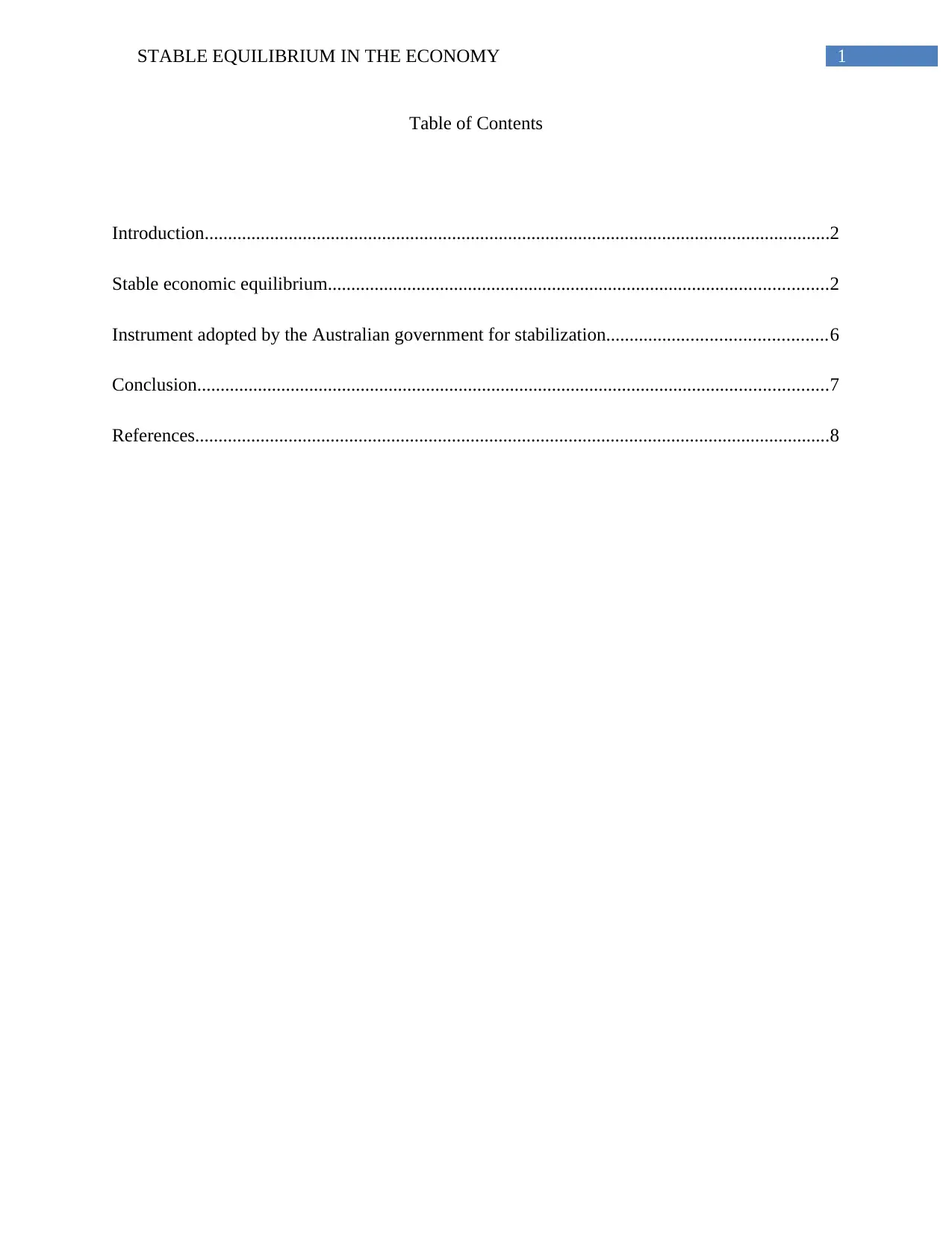
1STABLE EQUILIBRIUM IN THE ECONOMY
Table of Contents
Introduction......................................................................................................................................2
Stable economic equilibrium...........................................................................................................2
Instrument adopted by the Australian government for stabilization...............................................6
Conclusion.......................................................................................................................................7
References........................................................................................................................................8
Table of Contents
Introduction......................................................................................................................................2
Stable economic equilibrium...........................................................................................................2
Instrument adopted by the Australian government for stabilization...............................................6
Conclusion.......................................................................................................................................7
References........................................................................................................................................8
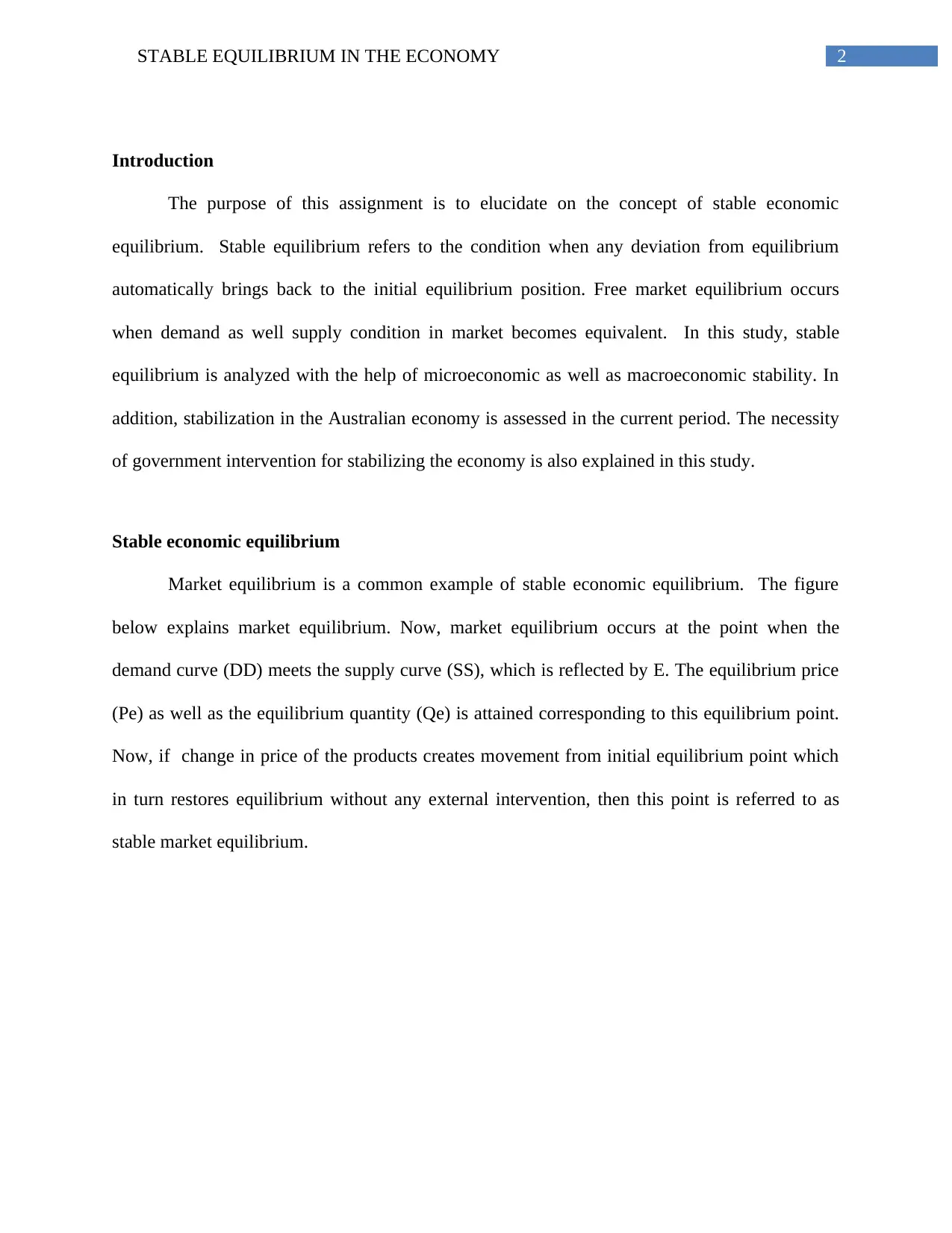
2STABLE EQUILIBRIUM IN THE ECONOMY
Introduction
The purpose of this assignment is to elucidate on the concept of stable economic
equilibrium. Stable equilibrium refers to the condition when any deviation from equilibrium
automatically brings back to the initial equilibrium position. Free market equilibrium occurs
when demand as well supply condition in market becomes equivalent. In this study, stable
equilibrium is analyzed with the help of microeconomic as well as macroeconomic stability. In
addition, stabilization in the Australian economy is assessed in the current period. The necessity
of government intervention for stabilizing the economy is also explained in this study.
Stable economic equilibrium
Market equilibrium is a common example of stable economic equilibrium. The figure
below explains market equilibrium. Now, market equilibrium occurs at the point when the
demand curve (DD) meets the supply curve (SS), which is reflected by E. The equilibrium price
(Pe) as well as the equilibrium quantity (Qe) is attained corresponding to this equilibrium point.
Now, if change in price of the products creates movement from initial equilibrium point which
in turn restores equilibrium without any external intervention, then this point is referred to as
stable market equilibrium.
Introduction
The purpose of this assignment is to elucidate on the concept of stable economic
equilibrium. Stable equilibrium refers to the condition when any deviation from equilibrium
automatically brings back to the initial equilibrium position. Free market equilibrium occurs
when demand as well supply condition in market becomes equivalent. In this study, stable
equilibrium is analyzed with the help of microeconomic as well as macroeconomic stability. In
addition, stabilization in the Australian economy is assessed in the current period. The necessity
of government intervention for stabilizing the economy is also explained in this study.
Stable economic equilibrium
Market equilibrium is a common example of stable economic equilibrium. The figure
below explains market equilibrium. Now, market equilibrium occurs at the point when the
demand curve (DD) meets the supply curve (SS), which is reflected by E. The equilibrium price
(Pe) as well as the equilibrium quantity (Qe) is attained corresponding to this equilibrium point.
Now, if change in price of the products creates movement from initial equilibrium point which
in turn restores equilibrium without any external intervention, then this point is referred to as
stable market equilibrium.
⊘ This is a preview!⊘
Do you want full access?
Subscribe today to unlock all pages.

Trusted by 1+ million students worldwide
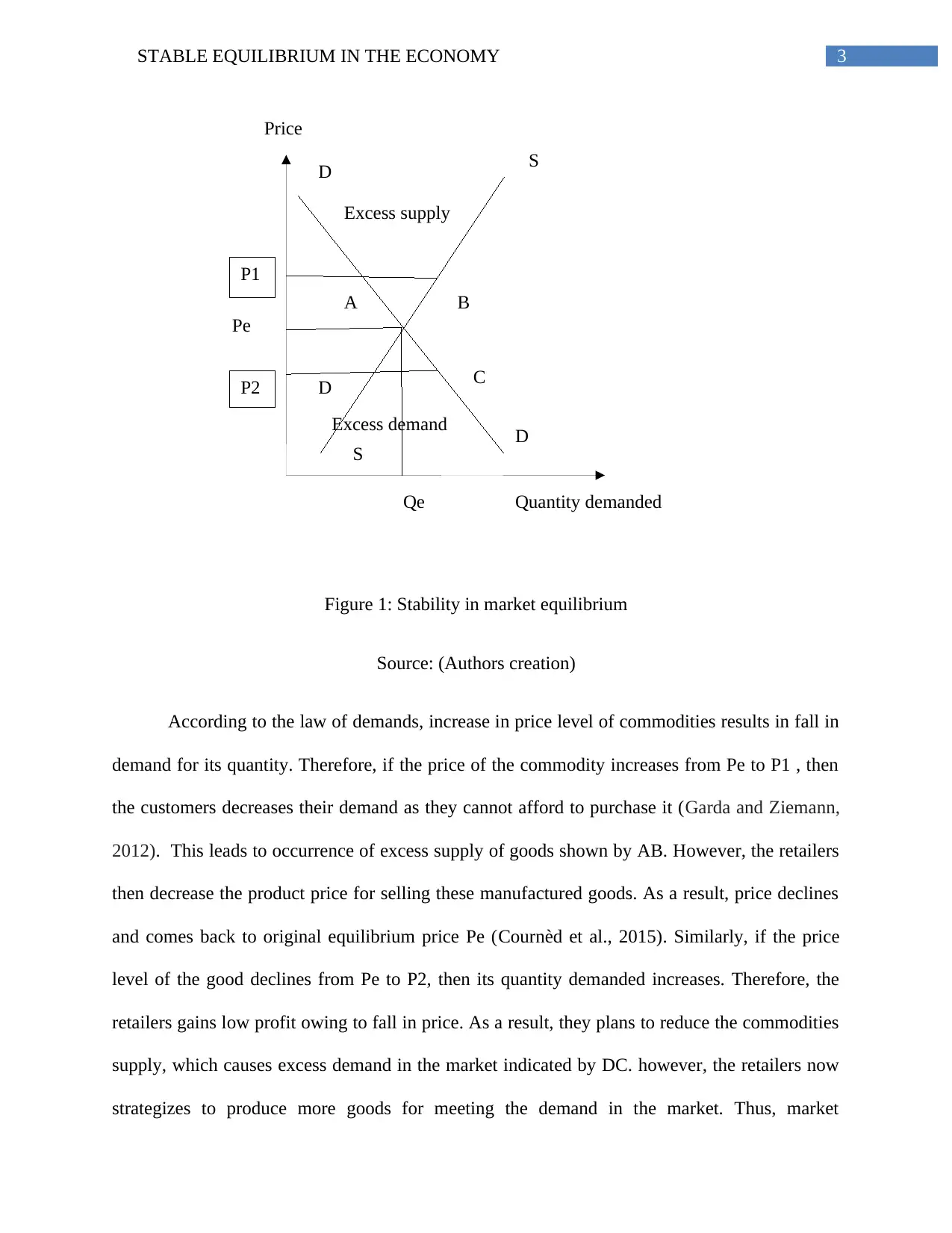
3STABLE EQUILIBRIUM IN THE ECONOMY
D
D S
S
Qe
Pe
Quantity demanded
Price
P1
P2
Excess supply
Excess demand
A B
C
D
Figure 1: Stability in market equilibrium
Source: (Authors creation)
According to the law of demands, increase in price level of commodities results in fall in
demand for its quantity. Therefore, if the price of the commodity increases from Pe to P1 , then
the customers decreases their demand as they cannot afford to purchase it (Garda and Ziemann,
2012). This leads to occurrence of excess supply of goods shown by AB. However, the retailers
then decrease the product price for selling these manufactured goods. As a result, price declines
and comes back to original equilibrium price Pe (Cournèd et al., 2015). Similarly, if the price
level of the good declines from Pe to P2, then its quantity demanded increases. Therefore, the
retailers gains low profit owing to fall in price. As a result, they plans to reduce the commodities
supply, which causes excess demand in the market indicated by DC. however, the retailers now
strategizes to produce more goods for meeting the demand in the market. Thus, market
D
D S
S
Qe
Pe
Quantity demanded
Price
P1
P2
Excess supply
Excess demand
A B
C
D
Figure 1: Stability in market equilibrium
Source: (Authors creation)
According to the law of demands, increase in price level of commodities results in fall in
demand for its quantity. Therefore, if the price of the commodity increases from Pe to P1 , then
the customers decreases their demand as they cannot afford to purchase it (Garda and Ziemann,
2012). This leads to occurrence of excess supply of goods shown by AB. However, the retailers
then decrease the product price for selling these manufactured goods. As a result, price declines
and comes back to original equilibrium price Pe (Cournèd et al., 2015). Similarly, if the price
level of the good declines from Pe to P2, then its quantity demanded increases. Therefore, the
retailers gains low profit owing to fall in price. As a result, they plans to reduce the commodities
supply, which causes excess demand in the market indicated by DC. however, the retailers now
strategizes to produce more goods for meeting the demand in the market. Thus, market
Paraphrase This Document
Need a fresh take? Get an instant paraphrase of this document with our AI Paraphraser
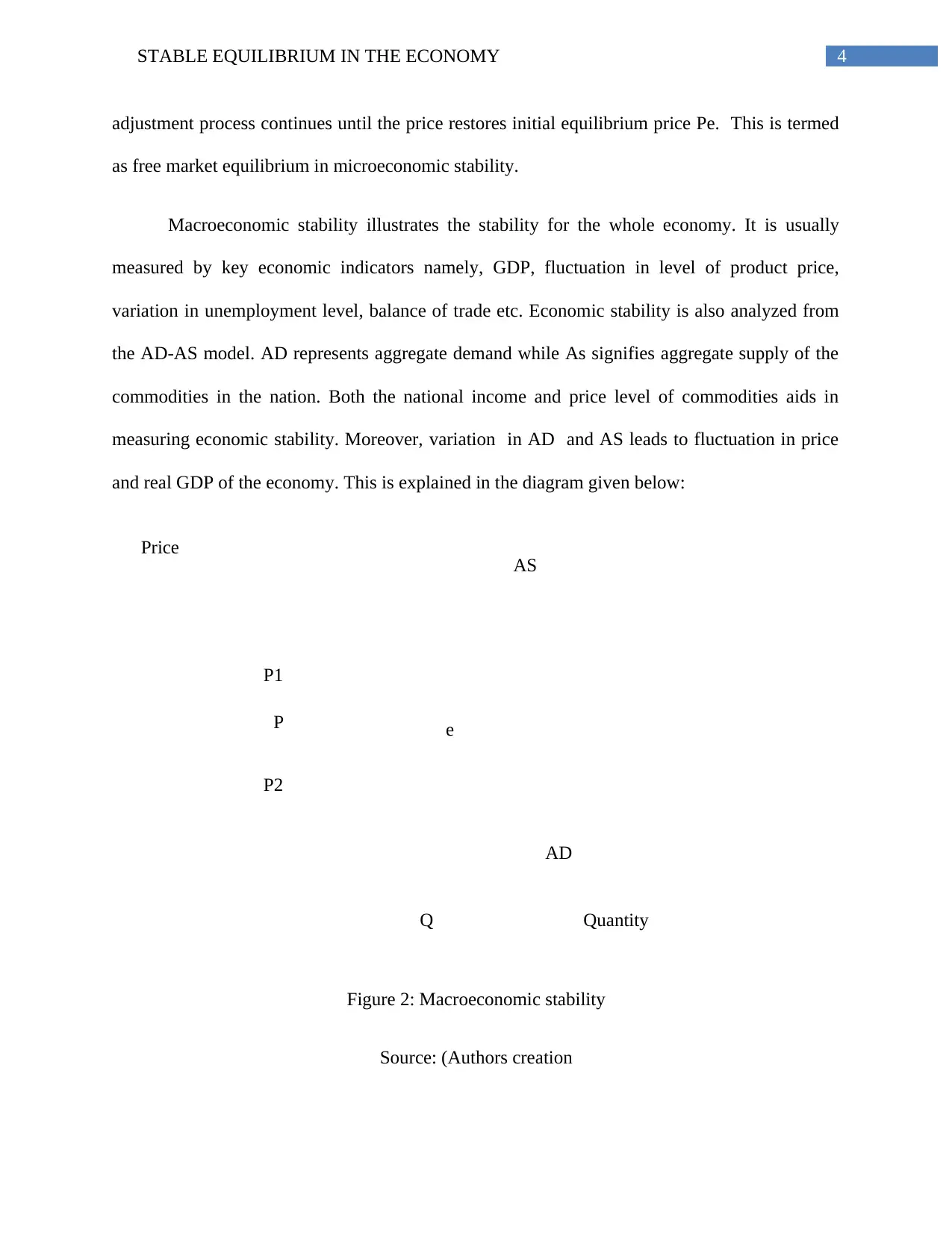
4STABLE EQUILIBRIUM IN THE ECONOMY
Quantity
AS
AD
P
Q
P1
P2
e
adjustment process continues until the price restores initial equilibrium price Pe. This is termed
as free market equilibrium in microeconomic stability.
Macroeconomic stability illustrates the stability for the whole economy. It is usually
measured by key economic indicators namely, GDP, fluctuation in level of product price,
variation in unemployment level, balance of trade etc. Economic stability is also analyzed from
the AD-AS model. AD represents aggregate demand while As signifies aggregate supply of the
commodities in the nation. Both the national income and price level of commodities aids in
measuring economic stability. Moreover, variation in AD and AS leads to fluctuation in price
and real GDP of the economy. This is explained in the diagram given below:
Figure 2: Macroeconomic stability
Source: (Authors creation
Price
Quantity
AS
AD
P
Q
P1
P2
e
adjustment process continues until the price restores initial equilibrium price Pe. This is termed
as free market equilibrium in microeconomic stability.
Macroeconomic stability illustrates the stability for the whole economy. It is usually
measured by key economic indicators namely, GDP, fluctuation in level of product price,
variation in unemployment level, balance of trade etc. Economic stability is also analyzed from
the AD-AS model. AD represents aggregate demand while As signifies aggregate supply of the
commodities in the nation. Both the national income and price level of commodities aids in
measuring economic stability. Moreover, variation in AD and AS leads to fluctuation in price
and real GDP of the economy. This is explained in the diagram given below:
Figure 2: Macroeconomic stability
Source: (Authors creation
Price
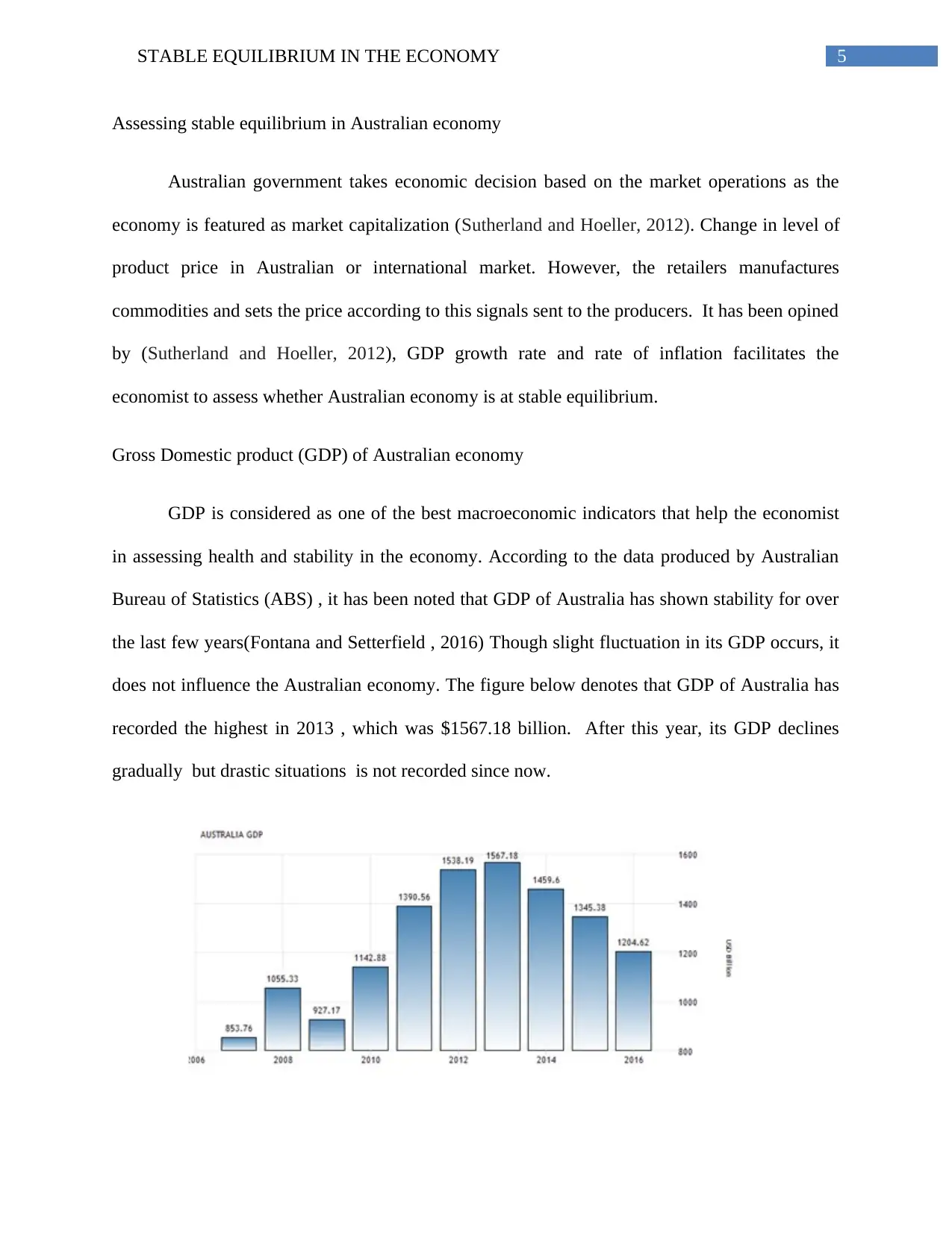
5STABLE EQUILIBRIUM IN THE ECONOMY
Assessing stable equilibrium in Australian economy
Australian government takes economic decision based on the market operations as the
economy is featured as market capitalization (Sutherland and Hoeller, 2012). Change in level of
product price in Australian or international market. However, the retailers manufactures
commodities and sets the price according to this signals sent to the producers. It has been opined
by (Sutherland and Hoeller, 2012), GDP growth rate and rate of inflation facilitates the
economist to assess whether Australian economy is at stable equilibrium.
Gross Domestic product (GDP) of Australian economy
GDP is considered as one of the best macroeconomic indicators that help the economist
in assessing health and stability in the economy. According to the data produced by Australian
Bureau of Statistics (ABS) , it has been noted that GDP of Australia has shown stability for over
the last few years(Fontana and Setterfield , 2016) Though slight fluctuation in its GDP occurs, it
does not influence the Australian economy. The figure below denotes that GDP of Australia has
recorded the highest in 2013 , which was $1567.18 billion. After this year, its GDP declines
gradually but drastic situations is not recorded since now.
Assessing stable equilibrium in Australian economy
Australian government takes economic decision based on the market operations as the
economy is featured as market capitalization (Sutherland and Hoeller, 2012). Change in level of
product price in Australian or international market. However, the retailers manufactures
commodities and sets the price according to this signals sent to the producers. It has been opined
by (Sutherland and Hoeller, 2012), GDP growth rate and rate of inflation facilitates the
economist to assess whether Australian economy is at stable equilibrium.
Gross Domestic product (GDP) of Australian economy
GDP is considered as one of the best macroeconomic indicators that help the economist
in assessing health and stability in the economy. According to the data produced by Australian
Bureau of Statistics (ABS) , it has been noted that GDP of Australia has shown stability for over
the last few years(Fontana and Setterfield , 2016) Though slight fluctuation in its GDP occurs, it
does not influence the Australian economy. The figure below denotes that GDP of Australia has
recorded the highest in 2013 , which was $1567.18 billion. After this year, its GDP declines
gradually but drastic situations is not recorded since now.
⊘ This is a preview!⊘
Do you want full access?
Subscribe today to unlock all pages.

Trusted by 1+ million students worldwide
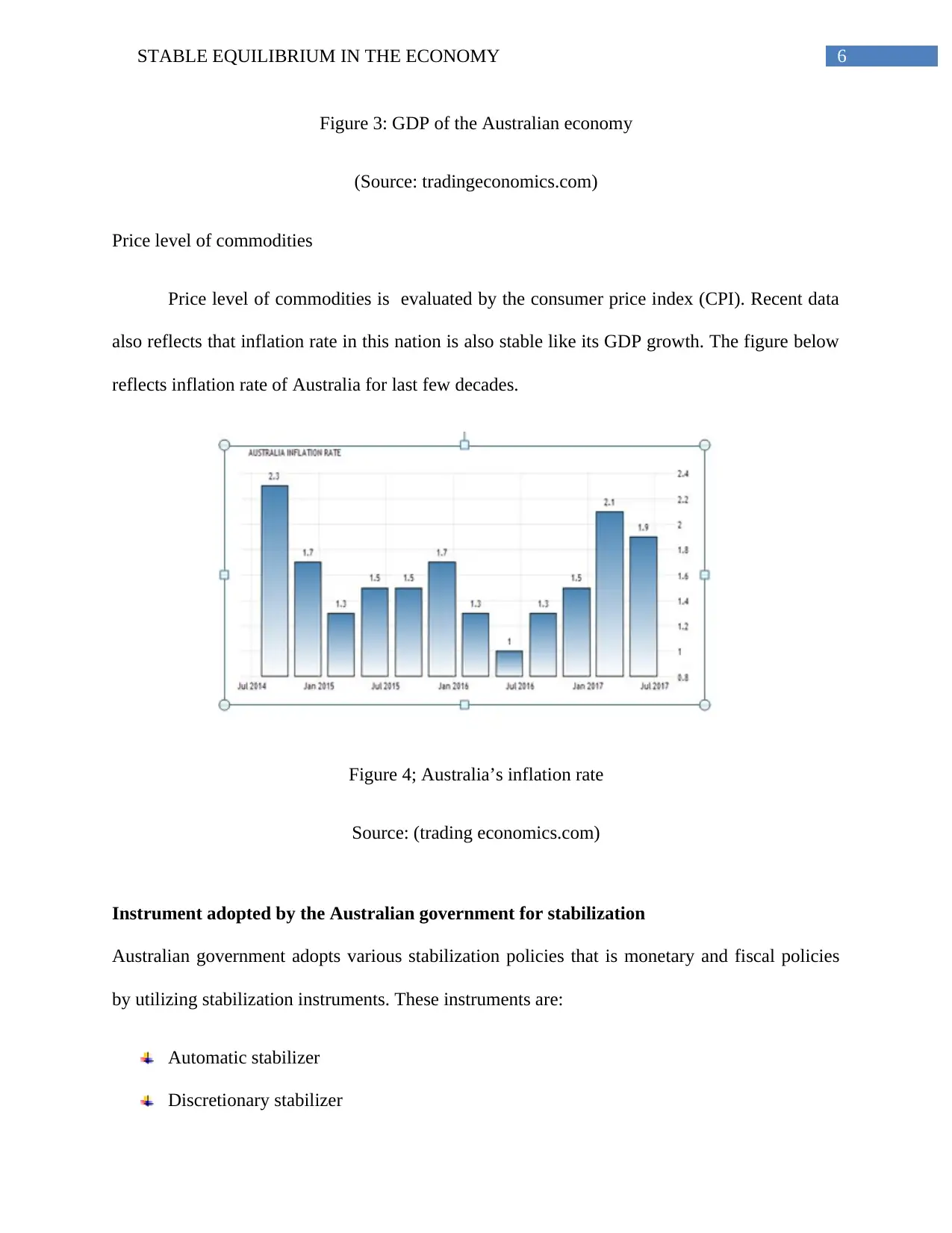
6STABLE EQUILIBRIUM IN THE ECONOMY
Figure 3: GDP of the Australian economy
(Source: tradingeconomics.com)
Price level of commodities
Price level of commodities is evaluated by the consumer price index (CPI). Recent data
also reflects that inflation rate in this nation is also stable like its GDP growth. The figure below
reflects inflation rate of Australia for last few decades.
Figure 4; Australia’s inflation rate
Source: (trading economics.com)
Instrument adopted by the Australian government for stabilization
Australian government adopts various stabilization policies that is monetary and fiscal policies
by utilizing stabilization instruments. These instruments are:
Automatic stabilizer
Discretionary stabilizer
Figure 3: GDP of the Australian economy
(Source: tradingeconomics.com)
Price level of commodities
Price level of commodities is evaluated by the consumer price index (CPI). Recent data
also reflects that inflation rate in this nation is also stable like its GDP growth. The figure below
reflects inflation rate of Australia for last few decades.
Figure 4; Australia’s inflation rate
Source: (trading economics.com)
Instrument adopted by the Australian government for stabilization
Australian government adopts various stabilization policies that is monetary and fiscal policies
by utilizing stabilization instruments. These instruments are:
Automatic stabilizer
Discretionary stabilizer
Paraphrase This Document
Need a fresh take? Get an instant paraphrase of this document with our AI Paraphraser

7STABLE EQUILIBRIUM IN THE ECONOMY
Automatic stabilizer
The government of this nation uses this instrument for designing the tax structures or
other purchases. Although federal policies implemented by Federal Bank are not directly
affected, aggregate demand is influenced counter cyclically (Corsetti et al., 2013). Based on the
present economic health of Australia, the government designs the budget accordingly. Tax
receipts including GST, PAYTG and excise tax are used under this tool.
Discretionary stabilizer
It is also termed as structural stabilizer. The Australian government uses this instrument
in order to introduce new tax or change the existing tax , declining government expenses in
industries like defenses, housing etc. Moreover, it helps the government in implementing the
policies that helps the economy in recovering from bad economic conditions.
Conclusion
It concludes from the above assignment that currently Australia has stable economic
equilibrium. The GDP slightly expanded over the years and thus remains stable. On the other
hand, inflation rate of Australia declined slightly but remained within the target level set by the
Reserve bank of Australia (RBA). Still government intervenes in the market by implementing
stabilization instrument in order to keep price level low and attain stable economic equilibrium.
Automatic stabilizer
The government of this nation uses this instrument for designing the tax structures or
other purchases. Although federal policies implemented by Federal Bank are not directly
affected, aggregate demand is influenced counter cyclically (Corsetti et al., 2013). Based on the
present economic health of Australia, the government designs the budget accordingly. Tax
receipts including GST, PAYTG and excise tax are used under this tool.
Discretionary stabilizer
It is also termed as structural stabilizer. The Australian government uses this instrument
in order to introduce new tax or change the existing tax , declining government expenses in
industries like defenses, housing etc. Moreover, it helps the government in implementing the
policies that helps the economy in recovering from bad economic conditions.
Conclusion
It concludes from the above assignment that currently Australia has stable economic
equilibrium. The GDP slightly expanded over the years and thus remains stable. On the other
hand, inflation rate of Australia declined slightly but remained within the target level set by the
Reserve bank of Australia (RBA). Still government intervenes in the market by implementing
stabilization instrument in order to keep price level low and attain stable economic equilibrium.
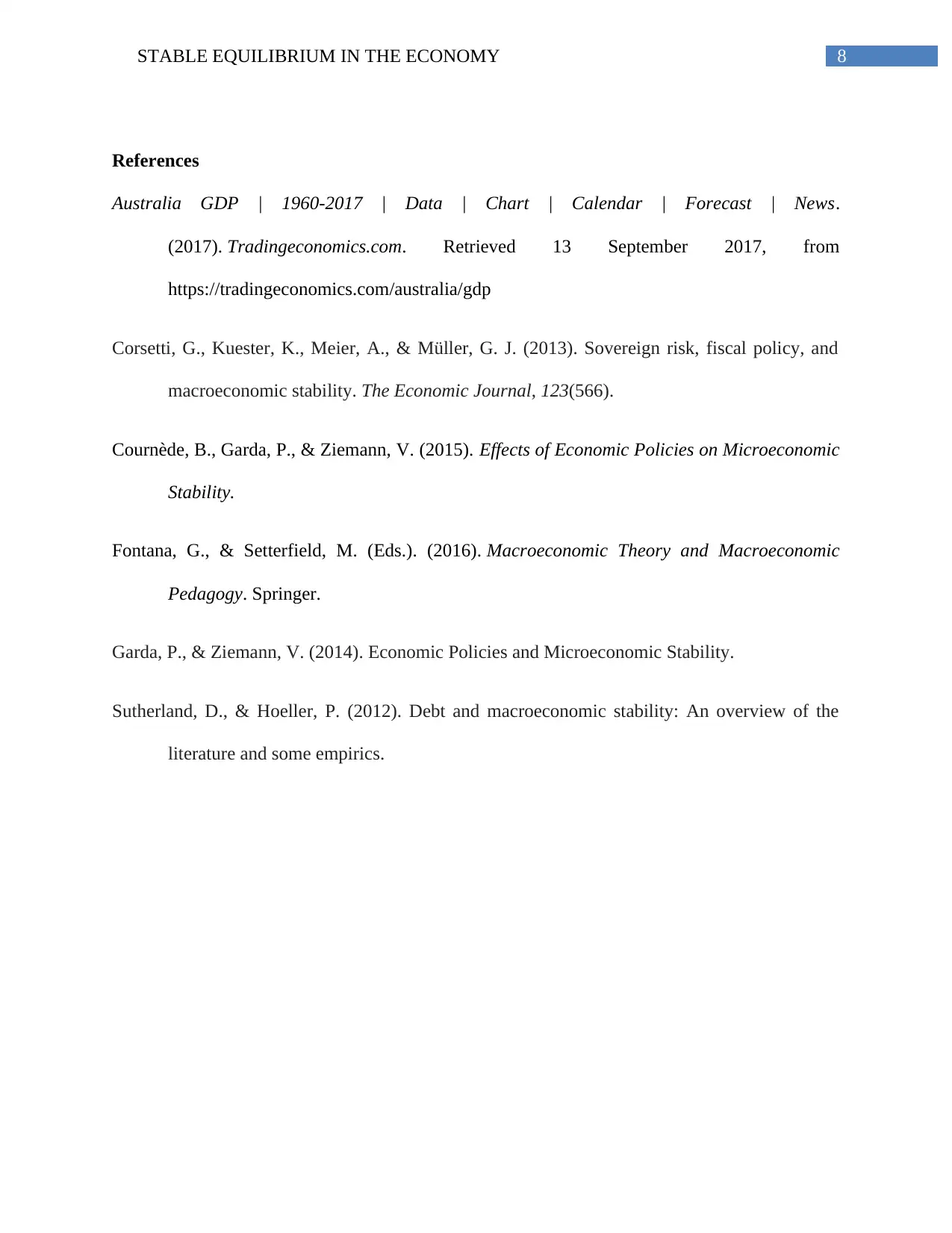
8STABLE EQUILIBRIUM IN THE ECONOMY
References
Australia GDP | 1960-2017 | Data | Chart | Calendar | Forecast | News.
(2017). Tradingeconomics.com. Retrieved 13 September 2017, from
https://tradingeconomics.com/australia/gdp
Corsetti, G., Kuester, K., Meier, A., & Müller, G. J. (2013). Sovereign risk, fiscal policy, and
macroeconomic stability. The Economic Journal, 123(566).
Cournède, B., Garda, P., & Ziemann, V. (2015). Effects of Economic Policies on Microeconomic
Stability.
Fontana, G., & Setterfield, M. (Eds.). (2016). Macroeconomic Theory and Macroeconomic
Pedagogy. Springer.
Garda, P., & Ziemann, V. (2014). Economic Policies and Microeconomic Stability.
Sutherland, D., & Hoeller, P. (2012). Debt and macroeconomic stability: An overview of the
literature and some empirics.
References
Australia GDP | 1960-2017 | Data | Chart | Calendar | Forecast | News.
(2017). Tradingeconomics.com. Retrieved 13 September 2017, from
https://tradingeconomics.com/australia/gdp
Corsetti, G., Kuester, K., Meier, A., & Müller, G. J. (2013). Sovereign risk, fiscal policy, and
macroeconomic stability. The Economic Journal, 123(566).
Cournède, B., Garda, P., & Ziemann, V. (2015). Effects of Economic Policies on Microeconomic
Stability.
Fontana, G., & Setterfield, M. (Eds.). (2016). Macroeconomic Theory and Macroeconomic
Pedagogy. Springer.
Garda, P., & Ziemann, V. (2014). Economic Policies and Microeconomic Stability.
Sutherland, D., & Hoeller, P. (2012). Debt and macroeconomic stability: An overview of the
literature and some empirics.
⊘ This is a preview!⊘
Do you want full access?
Subscribe today to unlock all pages.

Trusted by 1+ million students worldwide
1 out of 9
Related Documents
Your All-in-One AI-Powered Toolkit for Academic Success.
+13062052269
info@desklib.com
Available 24*7 on WhatsApp / Email
![[object Object]](/_next/static/media/star-bottom.7253800d.svg)
Unlock your academic potential
© 2024 | Zucol Services PVT LTD | All rights reserved.





